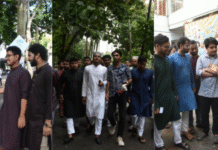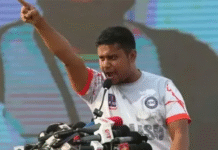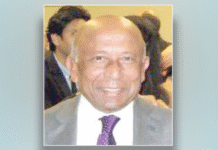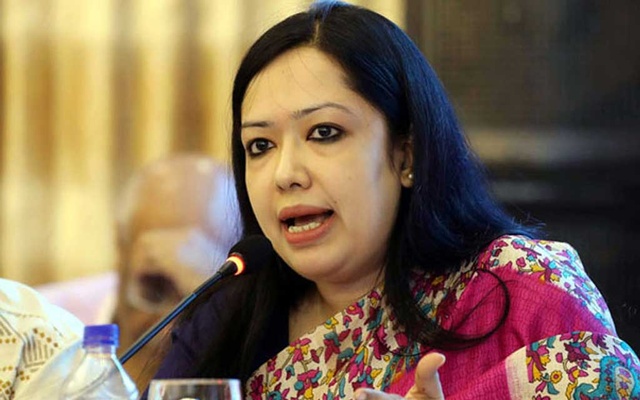As I watch Gaza, I can’t help but think about what’s been inflicted on the Rohingya in Myanmar and the role Israel has played in it, writes Burmese activist Maung Zarni.
by Maung Zarni
Eight years ago, the Myanmar armed forces launched a textbook genocide, physically destroying the Rohingya people in their own ancestral region in Rakhine state. Myanmar’s army set entire Rohingya villages ablaze. Thousands were killed. Women, girls, and the elderly were raped.
It was perhaps the first images of ethnic cleansing to this scale – masses of people being forced to leave their lands – televised on our screens. The violence continues today, even as we watch yet another genocide unfold before our eyes. As I watch what is happening in Gaza, I cannot help but think about a similarly genocidal violence perpetrated on the largely defenseless civilian population of Rohingya in my native Myanmar and the role Israel has played in it.
There are, of course, a lot of differences between what is happening to the Rohingya and the unconcealed war of annihilation being inflicted on the Palestinians in Gaza. For one, Israel’s genocide in Gaza is being supported and funded by the United States. Importantly, as well, the Holocaust memorial museums led by the one in Washington have acknowledged Myanmar’s persecution of the Rohingya as genocide. In sharp contrast, these same institutions have failed in their responsibility to apply their “Never Again” slogan to Gaza’s Palestinians. But both genocides are being carried out by two apartheid states – both established in 1948, who have largely enjoyed good relations (Israel itself has sold tens of millions of dollars in weapons to Myanmar’s military) – against the predominantly Muslim peoples they’ve persecuted for decades, all while the world watches on.
As we mark Rohingya Genocide Remembrance Day, it’s important to reflect on the ongoing genocide of the Rohingya, what we haven’t learned from the eight years of violence, displacement, dispossession, and, painfully, the impotence of international law in the face of sheer military might and attempted land grab in two very different parts of the world.
Who Are the Rohingya?
Several decades before the headline-making mass exodus of Rohingya in August 2017, Myanmar subjected this predominantly Muslim population to a slow process of group destruction, using both law and orchestrated campaigns of violence.
Since the military coup in 1962, Myanmar’s generals have built a multi-tiered citizenship system anchored in the notion of racial purity, enshrined in the 1982 Citizenship Act. Myanmar bears all the hallmarks of an apartheid state, with Buddhist Burmese at the top, and Rohingya and other Muslims at the bottom. After 1982, Rohingya were no longer able to obtain citizenship; instead, they were given foreign identification cards, which became integral to the genocide itself. As a matter of policy, Myanmar limited their educational opportunities and the type of work they could do, and made them a stateless people on their own ancestral land.
Periodic incidents of large-scale exodus of the Rohingya began as early as 1978, as the military violently forced out large numbers of Rohingya across the border into the newly independent Bangladesh, a Muslim-majority country.
In 2011, Myanmar transitioned to a military-dominated civilian government and set off on what, at the time, was considered the country’s reformist era – a period that was lauded by Western governments, including the US, with then-President Barack Obama and his Secretary of State Hillary Clinton praising as example of reforming authoritarians which “the rogue states” of North Korea and Iran should emulate.
Things, however, did not improve for the Rohingya.
In a study looking at the treatment of the group from 2011 to 2014, my colleague, Natalie Brinham (who at the time published under her penname Alice Cowley), and I found that since 1978, Rohingya had been denied and deprived of livelihoods opportunities, freedom of movement both inside their ancestral region of Rakhine and throughout other parts of the country, access to education, healthcare, and protection of the law enforcement agencies.
By 2015, pro-democracy leader and Nobel laureate Aung San Suu Kyi, who had been imprisoned or under house arrest for nearly two decades, had become the de facto leader of the country. She continued to be lauded by the Western community, despite her silence on the Rohingya. When she broke her silence, she blamed violence in Rakhine state on “terrorists,” echoing Myanmar’s military’s standard talking point. It was also in synch with the West’s jaundiced Orientalist view that any acts of armed resistance against oppression and occupation are “terrorism” when freedom fighters are Muslims.
On Aug. 25, 2017, Myanmar’s celebrated democrats and human rights defenders discarded any pretense of building an open society based on ethnic equality and rights for all. For weeks, the world witnessed the first livestreamed mass exodus of Rohingya, young and old, filing across the largely land and river borders into Bangladesh, against the backdrop of their agricultural land with smoke billowing over 300 villages razed to the ground by the country’s military’s artillery fire and systematic torching. Death and destruction in the name of Myanmar’s self-defense against the “Muslim terrorists” from the primitively armed Arakan Rohingya Salvation Army, which reportedly ambushed security outposts in Rakhine.
More than 740,000 Rohingya were forced to flee their ancestral homeland due to the violence. According to the BBC, 6,700 Rohingya, including 730 children under 5, were killed in the first month of the Myanmar military’s genocidal violence. Today, there are a little over 1 million Rohingya living in refugee camps across the border in Bangladesh.
The 600,000 Rohingya who remain in Western Myanmar face a new genocidal killer eight years on. The Arakan Army, which represents the economic interests and political ambitions of the local Buddhist ethnic Rakhine, has taken control of the entire Rohingya ancestral land in Northern Rakhine, after having routed out Myanmar’s embattled national military following the onset of the civil war triggered by the 2021 military coup. This month, Amnesty International, Human Rights Watch, and dozens of Myanmar and other human rights organizations said “(t)he Arakan Army in recent years has committed serious abuses against the Rohingya, including extrajudicial executions, torture, forced labor and large-scale arson. An estimated 150,000 Rohingya have fled to Bangladesh since mid-2024.”
The state’s local ethnic Rakhine population, almost exclusively Buddhists, outnumbered the 2 million Muslim Rohingya by 3:1 before the 2017 exodus. Their virulent fear and loathing of Muslims have led many to partake in the military-controlled state’s systematic attempt to erase both Rohingya identity and their existence from Myanmar’s ethnic histories. While fighting for their own political liberation from the majoritarian ethnic Burmese Buddhist population, the Rakhine are also cut from the same Islamophobic fabric.
Israel and Myanmar: An Early ‘Love Affair’
Genocides as acts of intentional destruction of human groups, in whole or in large part, are widely viewed as the crime of all crimes. The UN Convention on the Prevention and Punishment of the Crime of Genocide, a binding interstate treaty, places treaty obligations on UN member states to prevent and act to end genocide.
A large number of the world’s people take genocide as an affront to their/our humanity as evidenced in the millions of people taking to the streets and clamoring for the end to Israel’s Nazi-like destruction in Gaza.
Rather perceptively, in covering the earliest wave of violent expulsion of nearly 200,000 Rohingya from Myanmar into Bangladesh in 1978, a journalist with the then Hong Kong-based Far Eastern Economic Review, speculated about the prospect for Rohingya refugees of Myanmar becoming Southeast Asia’s “Palestinians” – violently deported en masse, and denied the right of return to their ancestral homes.
Both Gaza and Myanmar, the two new states – one gaining independence and one created out of the ashes of World War II and the dissolution of old colonial empires in 1948, now find themselves credibly accused of breaching their obligations under the Genocide Convention. In the “Merit Phase” of the ICJ proceedings, both states have been ordered to stop any further acts of genocidal persecution and destruction of Palestinians and Rohingya.
The relationship between Myanmar and Israel in their formative years was “a love affair,” as the late Israeli Prime Minister Golda Meir put it in her autobiography My Life: Golda Meir. Israel has been one of the most reliable arms suppliers and trainers for the Myanmar military and security forces since the mid-1950s. Both states have built themselves as apartheid ethnocracies. Both have ignored the World Court’s orders to abide by humanitarian and criminal law.
Beyond national boundaries of the crime scenes, there are also typically circles of collaborating states and corporate and multilateral institutions that not only allow genocide to happen, but also help support it. In Myanmar’s Rohingya case, Israeli arms suppliers and Meta’s Facebook have been accused of being complicit. The Israeli military, with the assistance of US tech giants of Silicon Valley, develops and tests its killing machines and surveillance tech in Gaza and the rest of Palestine.
Meanwhile, the two respective societies have descended into the abyss of supremacist racism cloaked in Buddhism and Judaism. While executioners and perpetrating states get the greatest attention, let us not forget the role of segments of a perpetrating society, who go along with the security forces as they pull the trigger. By the time a political regime is confident enough and able to carry out genocide, you can be sure that society at large has already been primed to support the state’s physical destruction of a targeted victim population. Genocides are not simply “state crimes”; they are often joint state-society crimes. The complacency and complicity of German society under the Nazi regime have been a template for genocides since then.
It was certainly excruciating for me, as a Burmese, to visit Rohingya refugee camps in Bangladesh shortly after the 2017 exodus and hear the harrowing tales of rape, killings, and arson that Rohingya were subjected to by the Myanmar military on the pretext of fighting Muslim terrorists.
Yet as a human, it was equally painful to hear the explosions inside Gaza as I stood with a delegation of largely American Rabbis for Ceasefire and Christians for Ceasefire at the southernmost crossing between Israel and Gaza known as Kerem Shalom or Kerem Abu Salem, one afternoon a year ago. I saw Israel’s military executioners on Made-in-USA tanks and armored vehicles coming out for cold drinks, presumably after their morning rounds of the destruction of Palestinians in the name of fighting an “anti-terror” war against Hamas.
This is the kind of piercing pain I have felt walking through the barracks and gas chambers at half a dozen death and concentration camps in Poland, Germany, and Austria, including Auschwitz, Dachau, Ravensbrück, Mauthausen, Sachsenhausen, and Neuengamme.
In Myanmar and Israel, where the genocides are both ongoing – the UN, ostensibly built to unite states against the twin evils of war and genocides has categorically failed to intervene to stop mass extermination.
The live-streamed exodus of roughly 740,000 Rohingya eight years ago – roughly the same number as Palestinians who were violently displaced during the 1948 Nakba – did not mark the end of Myanmar’s genocidal persecution and destruction, just as the Nakba or the 1967 Naksa did not mark the end of the catastrophe for Palestinians.
I want to end my reflection on genocide as a Buddhist Burmese, with the words of my Palestinian host and Christian brother Omar Haramy, director of Sabeel, the Palestinian liberation theology center in Jerusalem:
“From the charred villages of the Rohingya to the besieged ruins of Gaza, from Sudan to Congo and to every land scarred by empire and silence—we do not see ‘others’; we see our own. The crucified peoples of history cry out not for charity, but for justice. To follow Christ is to hear their cry as our own, to stand not beside power, but against it. Neutrality is complicity. Our faith begins where we choose the oppressed, not the empire.”
Maung Zarni (or only Zarni in Burmese) is an American-educated, UK-based dissident and genocide scholar from Myanmar with nearly 40 years of involvement in human rights activism and anti-imperialist politics. He co-founded and has led Free Burma Coalition, Free Rohingya Coalition, and Forces of Renewal Southeast Asia.














